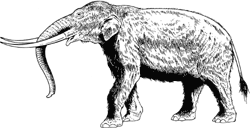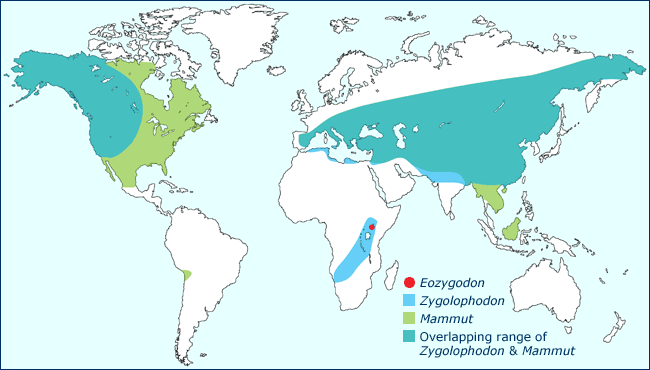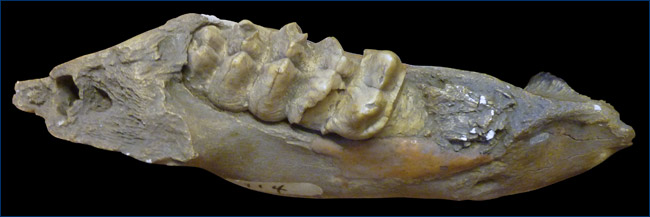
The Mammutidae
Mastodons
 The American Mastodon, Mammut americanum. |
Eozygodon morotoensis is the earliest known mastodon from 22 million years ago (early Miocene). Its fossil remains have been found in Uganda and Kenya (Figure 2). The next mastodon on the scene, Zygolophodon, had a widespread distribution, with populations in Africa, Europe, Asia and North America. Migrating from Africa, the genus first appears in Europe in the late early Miocene (17–19 million years ago). By the middle Miocene it is well represented in central and eastern Asia. The genus Mammut evolved in the late Miocene and persisted through the Pliocene and Pleistocene. Mammut is thought to be a descendant of Zygolophodon, with M. borsoni inhabiting Asia and M. americanum populating North America (Tobien et al. 1988)). Mastodons entered North America during the middle Miocene (11–16 million years ago). There are two competing hypotheses for the origin of North American mastodons. The first hypothesis proposes that Mammut migrated to North America during the Pliocene via the Bering Land Bridge, suggesting a sister species relationship between M. americanum and M. borsoni. The second hypothesis suggests that M. americanum is a descendant of Zygolophodon merriami which migrated to North America via the Bering Land Bridge. M. americanum survived in North America (reaching Central America but not South America) until the Pleistocene-Holocene boundary (~10,000 years ago). In Eurasia, mastodons went extinct during the Pliocene, making M. americanum the last remaining mastodon.
 Global mastodon distributions. |
The evolution of the mastodon lineage had the following trends: reduction and loss of the lower tusks, adaptation to browsing behavior with the upper tusks, and increased body size.
 A partial mastodon jaw with a tooth in place. Compare this zygolophodont tooth with a mammoth tooth. |
Mastodons could shear and cut vegetation with their zygolophodont dentition. They browsed on trees, shrubs and herbs and were also facultative grazers utilizing grassland habitats. They mostly lived in forests, woodlands, and wetlands.
New content researched and written by Kaitlin Maguire, 11/2010; mastodon jaw photo by Kaitlin Maguire